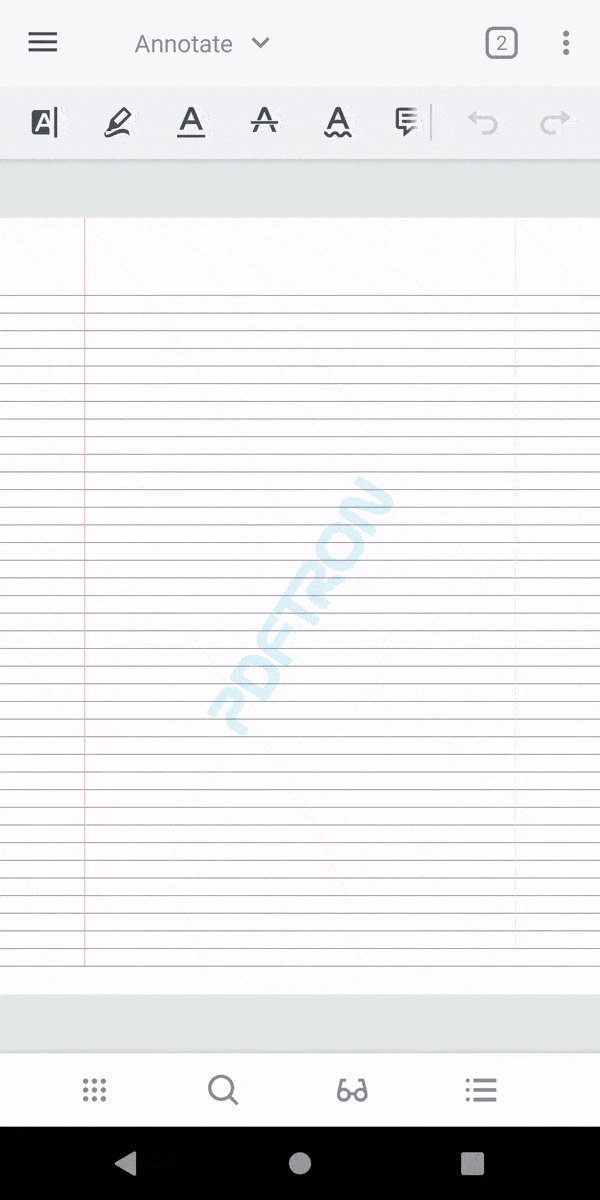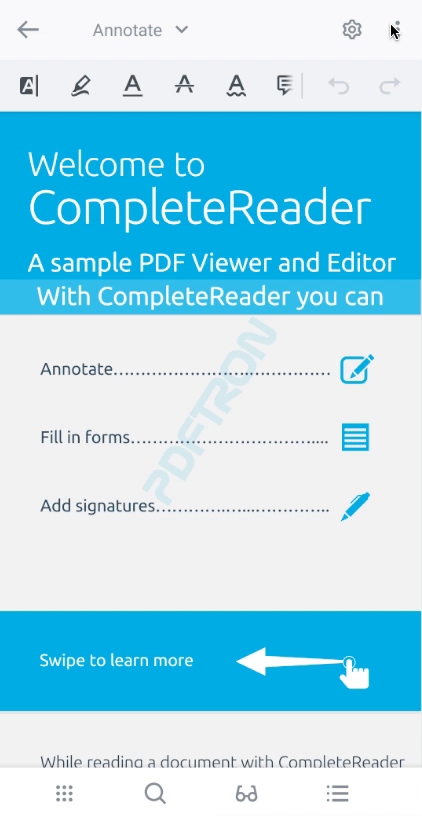Product:
Display document in fragment in Xamarin
This tutorial only applies to Xamarin.Android.
All actions related to the PDF viewer are handled through the PdfViewCtrlTabHostFragment2. This fragment extends androidx.fragment.app.Fragment and is responsible for showing documents in tabs.

Prerequisites
- Integrated Apryse into your project and added the
PDFTron.Android.ToolsNuGet package into your project. - Minimum API: 16 (using AndroidX)
- Compile API: 35
- Recommended target API: 35
No trial license key required.
The trial of Apryse Mobile SDK does not require a trial key. A commercial license key is required for use in a production environment. Please contact sales to purchase a commercial key or if you need any other license key assistance.
Keep your license keys confidential.
License keys are uniquely generated. Please make sure that it is not publicly available (e.g. in your public GitHub).
Step 1: Update AndroidManifest.xml
- In order to support all the features in
PdfViewCtrlTabHostFragment2, we will need to add the Android permissions listed in this table. However if you would like to disable certain features and customize your document viewer, you should leave out unnecessary permissions.
Storage permission
Please note that from Android 6.0 (API 23) and up, applications need to request storage permission at runtime before accessing any files on device.
- Enable
largeHeapandusesClearTextTraffic:
XML
If your app is targeting Android SDK version 28 or higher, you will need to add the android:usesCleartextTraffic="true" attribute in your application tag to open HTTP files in the viewer. If you are only working with HTTPS files, this is not required.
- Define your Activity to extend
AppCompatActivityand use an AppCompat theme:
C#
- If you have not done so already, add your license in the
AndroidManifest.xmlfile. The finalAndroidManifest.xmlfile should look something like this:
XML
Step 2: Launch the viewer
Use ViewerBuilder2 to create an instance of PdfViewCtrlTabHostFragment2, and add it to your activity layout. To add a document viewer fragment for a given password-protected file, call the following method in your activity:
C#
where fragmentContainer is the resource id of a layout in your activity that will contain your fragment:
For example:
XML
Alternatively if you have extended PdfViewCtrlTabFragment2 or PdfViewCtrlTabHostFragment2, you can specify your custom classes using the ViewerBuilder2.usingTabClass() method and the ViewerBuilder2.build() method as follows:
C#
Since Apryse uses the Fragment class from the Support Library, your activity must extend AppCompatActivityand call getSupportFragmentManager() to get the FragmentManager.
Step 3: Customize the viewer
Customize document viewer style
- If you would like to customize the appearance of the viewer activity, define
PDFTronAppThemeinstyles.xml:You can learn more about this in the customize the viewer's theme guide .
XML
PdfViewCtrlTabHostFragment2 uses the AppCompat theme for material colors. Make sure that the value of android:theme in your activity tag also extends the AppCompat theme.
Customize using ViewerConfig
- If you would like to customize certain viewer settings or the UI of
PdfViewCtrlTabHostFragment2, you can useViewerConfig.Builder. For example:
C#
For details on customizing the UI and using ViewerConfig.Builder, check out the configuration tutorial .
Customize the options toolbar

The default toolbar menu consists of the following buttons on phones:
- App navigation
- Toolbar switcher
- Tab switcher
- Overflow menu
The default toolbar menu consists of the following buttons on tablets:
- App navigation
- Toolbar switcher
- Document text search
- View mode configuration
- Thumbnails browser
- List container
- Overflow menu
You can fully customize the toolbar menu and the navigation icon by calling the following in ViewerBuilder2, with custom menu resource and drawable resource files:
C#
To change the icon color and overflow icon color, in styles.xml:
XML
To change the navigation icon color, in styles.xml (assume MyTheme is used as the app theme):
C#
Step 4: Interact with the fragment
If you would like to interact with the host fragment you can override the methods that you are interested in through events. For example, you may want to override ToolbarOptionsItemSelected when you add a new menu item, so when the item is clicked you can get a callback. As another example, you can get the callback when the navigation icon is clicked if you override NavButtonPressed.
Here's an example that replaces the default navigation icon and uses a custom toolbar:
C#
where ic_arrow_back_white_24dp.xml is a drawable resource file for a back arrow icon, and my_custom_toolbar.xml is a menu resource file that contains:
XML
This sample replaces the navigation icon, removes all toolbar buttons except the annotation toolbar button, and adds a new Show Toast button:

Did you find this helpful?
Trial setup questions?
Ask experts on DiscordNeed other help?
Contact SupportPricing or product questions?
Contact Sales